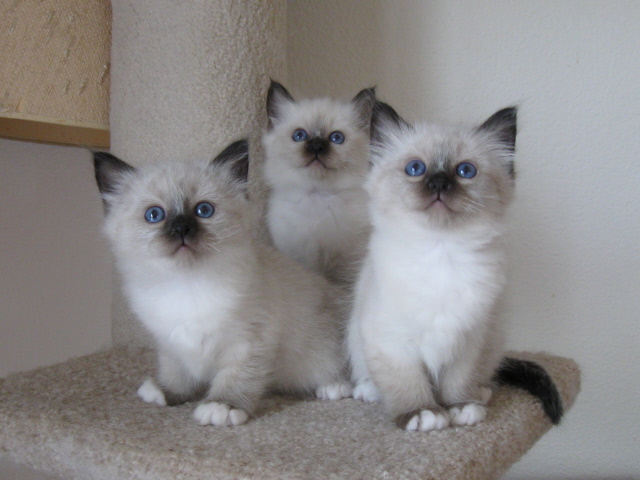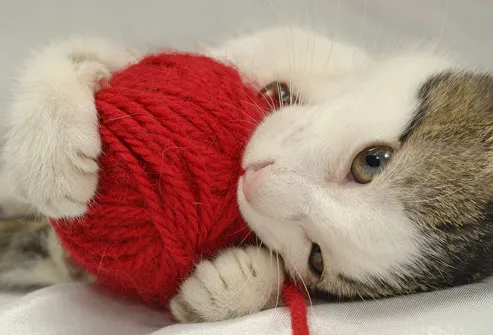
* Early on, there are few outward signs of pregnancy.
* The cat may adopt a more serene disposition.
* Sensible nesting activity begins.
Pregnancy in cats lasts about nine weeks, but during the first half of that time a typical expectant cat gives few clues that she is pregnant. She hunts, rests, and generally behaves normally.
Under the influence of progesterone, the hormone of pregnancy, and with an ever increasing weight in her abdomen, she soon moderates her behavior, gradually reducing her activity level and resting more.
Is my cat pregnant?
If you think your cat might be pregnant, the first check her nipples. These become more prominent and pinker by three weeks of gestation. By four to five weeks after conception, your vet will be able to feel golf-ball sized swellings in her abdomen. At this time the developing fetuses are usually quite easy to count. Shortly afterward, her belly becomes a visibly enlarged.
Multiple fathers
Unplanned breeding of pedigree females by both pedigree and non-pedigree males, producing litters of both purebred and crossbred kittens, confirmed what breeders had long expected: a litter may be sired by several males. This could have a survival potential for the offspring.
In large cats, such as the lion, when a new male takes over a pride, it is not uncommon for him to kill all cubs sired by the previous dominant male.
The frequency of infanticide in domestic cats is unknown, but at least one highly respected world authority, zoologist David MacDonald of Oxford University, England, has observed a strange male cat enter a communal nest among bales of hay and kill six kittens belonging to three mothers before the cries of the survivors brought the mothers running back.
Risks during pregnancy
The greatest risk to unborn kittens occurs during the first three weeks of development in the womb. Both drugs and infections might seriously impair healthy development. If, for example, the mother is exposed to feline infectious enteritis (FIE, or panleukopenia) at this time, the surviving kittens will be born with severe brain damage. Even exposure to live panleukopenia vaccine is dangerous. Cats should be vaccinated before they are pregnant, to increase the amount of passive protection they pass in the first milk to their kittens.
Never vaccinate pregnant cats to increase the level of inherited protection. Never vaccinate other cats in the household of a pregnant cat. Live vaccine virus can be shed by vaccinated cats and affect the pregnant cat’s fetuses.
Pregnancy and hormones
During pregnancy, the production of progesterone rapidly increases, peaking at around the 35th day after conception. This induces the more serene disposition of pregnancy. At the same time, the belly starts becoming visibly more rotund.
Pregnancy can be as short as 57 days or as long as 70 days, but a few days before birth the female becomes restless and searches out her chosen shelter.
She rearranges her bedding material and spends increasing amounts of time in her chosen nest. This impregnates the region with her own scent, something that will eventually help her kittens orient themselves toward home.
As birth approaches, the mother loses her appetite and restlessly paces in the nest until contractions begin.
Pregnancy checklist
1. Do not even think of breeding from your cat unless you know you can find homes for the resulting litter.
2. Do not breed from your cat until she is emotionally as well as physically mature.
3. Ensure that your cat is well nourished during pregnancy, and especially after, during her period of milk production.
4. Test your cat and the proposed father, to ensure they are not carriers of viral diseases such as FIV or FeLV.
5. Do not let your cat "follow nature’s course" and breed with a feral tom. Feral toms are excellent breeders. They are also the most likely source of life-threatening infections such as FIV, FeLV, and feline infectious peritonitis (FIP)
Cats do not become visibly pregnant until after about five weeks. Shortly before this time, your vet will be able to tell you how large the litter will be.
A few days before birth, a pregnant cat will begin looking for a good nest, which she will scent-mark. This will help her newborns recognize home.
 Providing for your pets' physical needs and caring for them with love and commitment are the first requirements of responsible pet owners. But these are not the only requirements. Pet caregivers cannot reasonably or responsibly ignore the impact their animals can have on neighbors. This is especially true of those living in multifamily rental properties. Here are a few common-sense rules to keep your neighbors happy—and your pet safe.
Providing for your pets' physical needs and caring for them with love and commitment are the first requirements of responsible pet owners. But these are not the only requirements. Pet caregivers cannot reasonably or responsibly ignore the impact their animals can have on neighbors. This is especially true of those living in multifamily rental properties. Here are a few common-sense rules to keep your neighbors happy—and your pet safe. 





 Hay
Hay * Early on, there are few outward signs of pregnancy.
* Early on, there are few outward signs of pregnancy. Sucking, and wool sucking in particular, is a common behaviour in cats. While the causes are unknown, it is most often seen in Siamese or Burmese cats, suggesting that there may be a genetic basis to this behaviour.
Sucking, and wool sucking in particular, is a common behaviour in cats. While the causes are unknown, it is most often seen in Siamese or Burmese cats, suggesting that there may be a genetic basis to this behaviour.